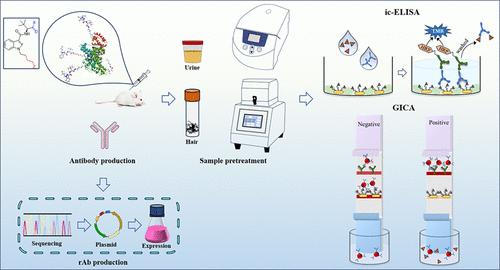基于单克隆抗体的广特异性免疫测定的建立,用于快速检测吲哚型和吲唑型合成大麻素及代谢物
IF 6.7
1区 化学
Q1 CHEMISTRY, ANALYTICAL
引用次数: 0
摘要
合成大麻素(SC)已成为滥用最严重的新型精神活性物质(NPS)类别之一,加剧了全球毒品问题并对公共健康构成重大威胁。目前,一类以吲唑或吲哚为核心的新型酰胺类SC已在大量非法药物使用案例中被发现,但仍缺乏SC检测的综合分析方法。本文制备了针对36种吲哚型和吲唑型SC及其代谢物的单克隆抗体(mAbs)2E4和AE6,其IC50范围为0.14-85.28 ng/mL,并阐述了抗体识别的分子机制。建立了基于mAbs 2E4和AE6的间接竞争性酶联免疫吸附测定法(ic-ELISA)和金免疫层析测定法(GICA),用于检测尿液和毛发样品中的吲唑类和吲哚类SCs。在最佳条件下,采用ic-ELISA法检测尿液中的ADB-BUTINACA(一种吲唑类SC)的检出限为0.11纳克/毫升,毛发中的检出限为0.024纳克/毫克;采用ic-ELISA法检测尿液中的ADB-BUTINACA(一种吲唑类SC)的检出限为1.02纳克/毫升,毛发中的检出限为0.046纳克/毫克。ic-ELISA法检测尿液中的4F-MDMB-BUTICA(一种吲哚型SC)的LOD为0.036 ng/mL,检测毛发中的4F-MDMB-BUTICA的LOD为0.012 ng/mg,GICA法检测尿液中的4F-MDMB-BUTICA的LOD为0.54 ng/mL,检测毛发中的4F-MDMB-BUTICA的LOD为0.03 ng/mg。总之,我们的研究为快速筛查和定量生物样本中的 SC 衍生物奠定了全面的基础。本文章由计算机程序翻译,如有差异,请以英文原文为准。

Establishment of Broad-Specificity Monoclonal Antibody-Based Immunoassay for Rapid Detection of Indole-Type and Indazole-Type Synthetic Cannabinoids and Metabolites
Synthetic cannabinoids (SCs) have emerged as one of the most severely abused categories of new psychoactive substances (NPS), exacerbating the global drug problem and posing significant threats to public health. Presently, a class of new amide-type SCs featuring an indazole or indole core has been identified in numerous cases of illegal drug use, but there is still a lack of comprehensive analysis methods of SC detection. Herein, monoclonal antibodies (mAbs) 2E4 and AE6 targeting 36 indole-type and indazole-type SCs and their metabolites with IC50 ranging from 0.14 to 85.28 ng/mL were prepared and the molecular mechanism of antibody recognition was elaborated. We established the indirect competitive enzyme-linked immunosorbent assay (ic-ELISA) and gold immunochromatography assay (GICA) based on mAbs 2E4 and AE6 to detect indazole-type and indole-type SCs in urine and hair samples. Under optimal conditions, the proposed method detected ADB-BUTINACA (an indazole-type SC) with limits of detection (LODs) of 0.11 ng/mL for urine and 0.024 ng/mg for hair by ic-ELISA, and 1.02 ng/mL for urine and 0.046 ng/mg for hair by GICA; the LODs of 4F-MDMB-BUTICA (an indole-type SC) detection was 0.036 ng/mL for urine and 0.012 ng/mg for hair by ic-ELISA, and 0.54 ng/mL for urine and 0.03 ng/mg for hair by GICA. Collectively, our study provides a comprehensive foundation for the rapid screening and quantitation of SC derivatives in biological samples.
求助全文
通过发布文献求助,成功后即可免费获取论文全文。
去求助
来源期刊

Analytical Chemistry
化学-分析化学
CiteScore
12.10
自引率
12.20%
发文量
1949
审稿时长
1.4 months
期刊介绍:
Analytical Chemistry, a peer-reviewed research journal, focuses on disseminating new and original knowledge across all branches of analytical chemistry. Fundamental articles may explore general principles of chemical measurement science and need not directly address existing or potential analytical methodology. They can be entirely theoretical or report experimental results. Contributions may cover various phases of analytical operations, including sampling, bioanalysis, electrochemistry, mass spectrometry, microscale and nanoscale systems, environmental analysis, separations, spectroscopy, chemical reactions and selectivity, instrumentation, imaging, surface analysis, and data processing. Papers discussing known analytical methods should present a significant, original application of the method, a notable improvement, or results on an important analyte.
 求助内容:
求助内容: 应助结果提醒方式:
应助结果提醒方式:


